国外化学方程式的书写
- 格式:doc
- 大小:39.50 KB
- 文档页数:2
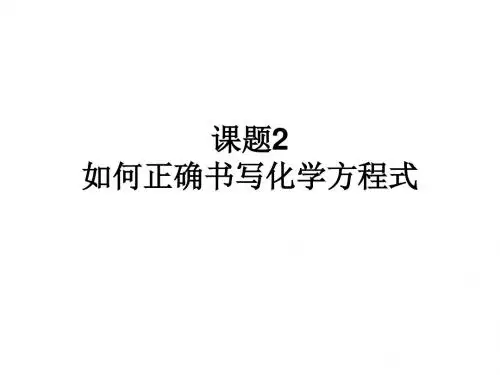
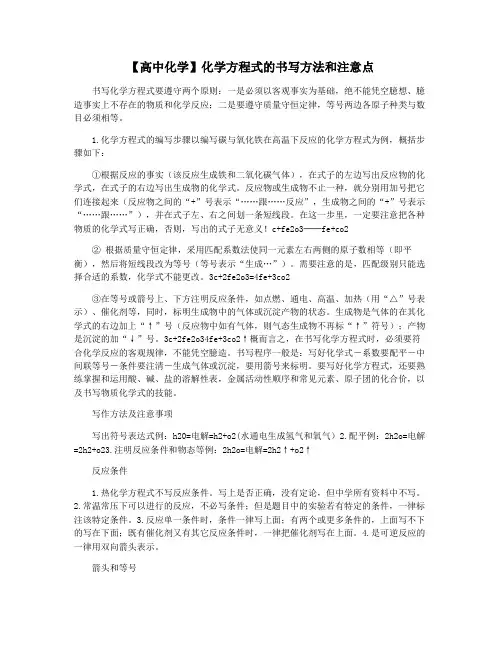
【高中化学】化学方程式的书写方法和注意点书写化学方程式要遵守两个原则:一是必须以客观事实为基础,绝不能凭空臆想、臆造事实上不存在的物质和化学反应;二是要遵守质量守恒定律,等号两边各原子种类与数目必须相等。
1.化学方程式的编写步骤以编写碳与氧化铁在高温下反应的化学方程式为例,概括步骤如下:①根据反应的事实(该反应生成铁和二氧化碳气体),在式子的左边写出反应物的化学式,在式子的右边写出生成物的化学式。
反应物或生成物不止一种,就分别用加号把它们连接起来(反应物之间的“+”号表示“……跟……反应”,生成物之间的“+”号表示“……跟……”),并在式子左、右之间划一条短线段。
在这一步里,一定要注意把各种物质的化学式写正确,否则,写出的式子无意义!c+fe2o3──fe+co2② 根据质量守恒定律,采用匹配系数法使同一元素左右两侧的原子数相等(即平衡),然后将短线段改为等号(等号表示“生成…”)。
需要注意的是,匹配级别只能选择合适的系数,化学式不能更改。
3c+2fe2o3=4fe+3co2③在等号或箭号上、下方注明反应条件,如点燃、通电、高温、加热(用“△”号表示)、催化剂等,同时,标明生成物中的气体或沉淀产物的状态。
生成物是气体的在其化学式的右边加上“↑”号(反应物中如有气体,则气态生成物不再标“↑”符号);产物是沉淀的加“↓”号。
3c+2fe2o34fe+3co2↑概而言之,在书写化学方程式时,必须要符合化学反应的客观规律,不能凭空臆造。
书写程序一般是:写好化学式―系数要配平―中间联等号―条件要注清―生成气体或沉淀,要用箭号来标明。
要写好化学方程式,还要熟练掌握和运用酸、碱、盐的溶解性表,金属活动性顺序和常见元素、原子团的化合价,以及书写物质化学式的技能。
写作方法及注意事项写出符号表达式例:h20=电解=h2+o2(水通电生成氢气和氧气)2.配平例:2h2o=电解=2h2+o23.注明反应条件和物态等例:2h2o=电解=2h2↑+o2↑反应条件1.热化学方程式不写反应条件。
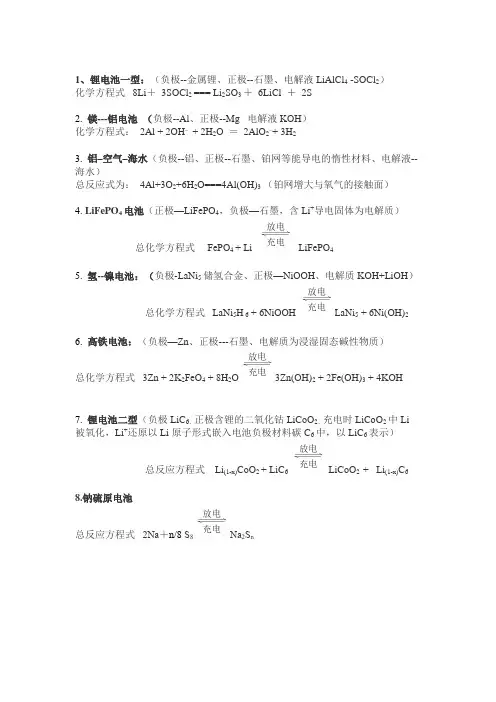
1、锂电池一型:(负极--金属锂、正极--石墨、电解液LiAlCl4 -SOCl2)化学方程式8Li+3SOCl2 === Li2SO3 +6LiCl +2S2.镁---铝电池(负极--Al、正极--Mg 电解液KOH)化学方程式:2Al + 2OH– + 2H2O =2AlO2–+ 3H23.铝–空气–海水(负极--铝、正极--石墨、铂网等能导电的惰性材料、电解液--海水)总反应式为:4Al+3O2+6H2O===4Al(OH)3(铂网增大与氧气的接触面)4. LiFePO4电池(正极—LiFePO4,负极—石墨,含Li+导电固体为电解质)总化学方程式 FePO4 + Li LiFePO45.氢--镍电池:(负极-LaNi5储氢合金、正极—NiOOH、电解质KOH+LiOH)总化学方程式LaNi5H 6 + 6NiOOH LaNi5 + 6Ni(OH)2 6.高铁电池:(负极—Zn、正极---石墨、电解质为浸湿固态碱性物质)总化学方程式3Zn + 2K2FeO4 + 8H2O3Zn(OH)2 + 2Fe(OH)3 + 4KOH 7.锂电池二型(负极LiC6、正极含锂的二氧化钴LiCoO2、充电时LiCoO2中Li 被氧化,Li+还原以Li原子形式嵌入电池负极材料碳C6中,以LiC6表示)总反应方程式 Li(1-x)CoO2 + LiC6 LiCoO2 + Li(1-x)C6 8.钠硫原电池总反应方程式2Na+n/8 S8Na2S n答案:1.负极:8Li -8e-=8 Li + (氧化反应)正极:3SOCl2+8e-=SO32-+2S+6Cl-(还原反应)2.负极(Al):2Al + 8 OH–- 6e- =2AlO2–+4H2O (氧化反应)正极(Mg):6H2O + 6e- =3H2↑+6OH–(还原反应)3.负极:4Al-12e-==4Al3+ (氧化反应)正极:3O2+6H2O+12e-==12OH-(还原反应)4.放电时负极:Li -e— ==Li + (氧化反应)正极:FePO4 + Li+ + e—== LiFePO4 (还原反应)充电时:阴极:Li+ + e—== Li (还原反应)阳极:LiFePO4-e—== FePO4 + Li+ (氧化反应)5.放电时负极:LaNi5H 6-6e—+ 6OH–== LaNi5 + 6H2O (氧化反应) 正极:6NiOOH +6e—+ 6H2O ==6 Ni(OH)2 + 6OH–(还原反应)充电时阴极:LaNi5 +6e—+ 6H2O== LaNi5H 6+ 6OH–(还原反应)阳极:6 Ni(OH)2 -6e—+ 6OH–== 6NiOOH + 6H2O (氧化反应)6.放电时负极:3Zn -6e- + 6 OH–== 3 Zn(OH)2 (氧化反应)正极:2FeO42—+6e-+ 8H2O ==2 Fe (OH)3 + 10OH–(还原反应)充电时阴极:3Zn(OH)2 +6e-==3Zn + 6 OH– (还原反应) 阳极:2Fe(OH)3-6e-+ 10OH–==2FeO42—+ 8H2O (氧化反应) 7.放电时负极: LiC6 – xe- =Li(1-x)C6 + x Li+ (氧化反应)CoO2 + xe- + x Li+ == LiCoO2(还原反应)正极:Li(1-x)充电时阴极:Li(1-x)C6 + x Li+ + xe- =LiC6 (还原反应)阳极:LiCoO2 – xe-=Li(1-x)CoO2 + x Li+(氧化反应)8.放电时负极: 2Na– 2e-== 2Na+(氧化反应)正极:n/8 S8 + 2e- == S n2-(还原反应)充电时阴极:2Na+ + 2e- == 2Na(还原反应)阳极:S n2- –2e- == n/8 S8(氧化反应)。
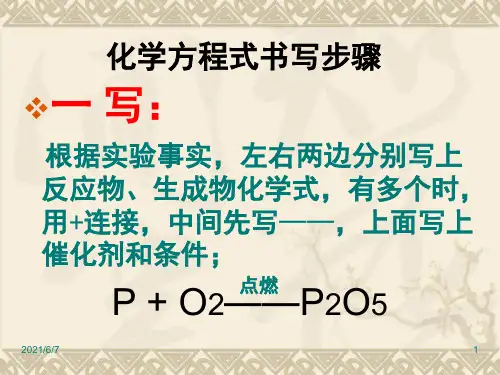
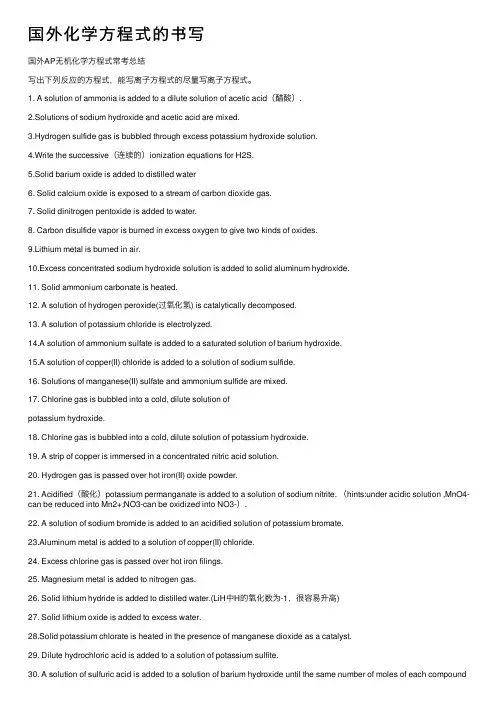
国外化学⽅程式的书写国外AP⽆机化学⽅程式常考总结写出下列反应的⽅程式,能写离⼦⽅程式的尽量写离⼦⽅程式。
1. A solution of ammonia is added to a dilute solution of acetic acid(醋酸).2.Solutions of sodium hydroxide and acetic acid are mixed.3.Hydrogen sulfide gas is bubbled through excess potassium hydroxide solution.4.Write the successive(连续的)ionization equations for H2S.5.Solid barium oxide is added to distilled water6. Solid calcium oxide is exposed to a stream of carbon dioxide gas.7. Solid dinitrogen pentoxide is added to water.8. Carbon disulfide vapor is burned in excess oxygen to give two kinds of oxides.9.Lithium metal is burned in air.10.Excess concentrated sodium hydroxide solution is added to solid aluminum hydroxide.11. Solid ammonium carbonate is heated.12. A solution of hydrogen peroxide(过氧化氢) is catalytically decomposed.13. A solution of potassium chloride is electrolyzed.14.A solution of ammonium sulfate is added to a saturated solution of barium hydroxide.15.A solution of copper(II) chloride is added to a solution of sodium sulfide.16. Solutions of manganese(II) sulfate and ammonium sulfide are mixed.17. Chlorine gas is bubbled into a cold, dilute solution ofpotassium hydroxide.18. Chlorine gas is bubbled into a cold, dilute solution of potassium hydroxide.19. A strip of copper is immersed in a concentrated nitric acid solution.20. Hydrogen gas is passed over hot iron(II) oxide powder.21. Acidified(酸化)potassium permanganate is added to a solution of sodium nitrite. (hints:under acidic solution ,MnO4-can be reduced into Mn2+;NO3-can be oxidized into NO3-).22. A solution of sodium bromide is added to an acidified solution of potassium bromate.23.Aluminum metal is added to a solution of copper(II) chloride.24. Excess chlorine gas is passed over hot iron filings.25. Magnesium metal is added to nitrogen gas.26. Solid lithium hydride is added to distilled water.(LiH中H的氧化数为-1,很容易升⾼)27. Solid lithium oxide is added to excess water.28.Solid potassium chlorate is heated in the presence of manganese dioxide as a catalyst.29. Dilute hydrochloric acid is added to a solution of potassium sulfite.30. A solution of sulfuric acid is added to a solution of barium hydroxide until the same number of moles of each compoundhas been added.31.Sulfur dioxide gas is passed over solid calcium oxide.32. A solution of potassium iodide is added to an acidified solution of potassium dichromate(Cr2O72-). (hints:under acidic solution , Cr2O72-can be reduced into Cr3+;I-can be oxidized into I2).。
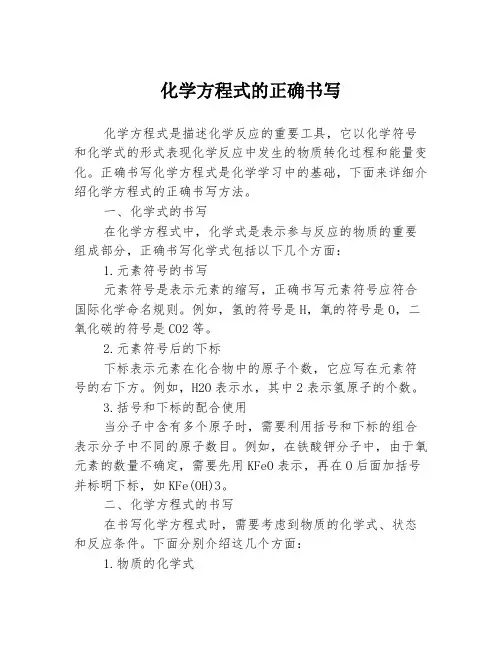
化学方程式的正确书写化学方程式是描述化学反应的重要工具,它以化学符号和化学式的形式表现化学反应中发生的物质转化过程和能量变化。
正确书写化学方程式是化学学习中的基础,下面来详细介绍化学方程式的正确书写方法。
一、化学式的书写在化学方程式中,化学式是表示参与反应的物质的重要组成部分,正确书写化学式包括以下几个方面:1.元素符号的书写元素符号是表示元素的缩写,正确书写元素符号应符合国际化学命名规则。
例如,氢的符号是H,氧的符号是O,二氧化碳的符号是CO2等。
2.元素符号后的下标下标表示元素在化合物中的原子个数,它应写在元素符号的右下方。
例如,H2O表示水,其中2表示氢原子的个数。
3.括号和下标的配合使用当分子中含有多个原子时,需要利用括号和下标的组合表示分子中不同的原子数目。
例如,在铁酸钾分子中,由于氧元素的数量不确定,需要先用KFeO表示,再在O后面加括号并标明下标,如KFe(OH)3。
二、化学方程式的书写在书写化学方程式时,需要考虑到物质的化学式、状态和反应条件。
下面分别介绍这几个方面:1.物质的化学式在化学方程式中,应写出反应物和生成物的化学式。
反应物和生成物的化学式应分别写在反应物和生成物的符号之后,并用“+”表示两者相加。
例如:2H2+O2→2 H2O 表示氢气和氧气反应生成水。
2.物质的状态化学反应发生时,反应的物质可能处于不同的状态,例如气态、液态、固态等。
为了在方程式中准确地描述反应物料的状态,通常在反应物料符号后用括号标示状态,如(s)表示固态,(l)表示液态,(g)表示气态等。
例如:H2O(l)表示水为液态。
3.反应条件不同反应条件下的反应产物也会有所不同,因此需要在方程式中标示出反应条件。
常用的反应条件包括温度、压力、催化剂等。
例如:2H2(g)+O2(g)→2H2O(g); ΔH=-484kJ/mol表示燃烧产生水同时放出热量。
总之,正确书写化学方程式至关重要,它能对化学学习和实验中的阅读理解、实验设计和变量控制等都有很大帮助。

化学方程式英文写法Chemical equations are written to represent chemical reactions in a concise and standardized way. They show the reactants on the left side and the products on the right side, with an arrow in between to indicate the direction of the reaction. Each substance is represented by its chemical formula or symbol, and the numbers in front of the formulas indicate the relative amounts of each substance involved.Chemical equations are important because they provide a way to communicate the details of a chemical reaction in a clear and systematic manner. They allow chemists to understand the stoichiometry of a reaction, which is the quantitative relationship between the reactants and products. This information is crucial for predicting the outcomes of reactions and for designing new chemical processes.In order to write a chemical equation, you need to first identify the reactants and products of the reaction. Then, you need to balance the equation by adjusting the coefficients in front of the chemical formulas so that the same number of each type of atom is present on both sidesof the equation. This is done using the principles of conservation of mass and the law of definite proportions.For example, let's consider the reaction betweenhydrogen gas (H2) and oxygen gas (O2) to form water (H2O). The balanced chemical equation for this reaction is: 2H2 + O2 → 2H2OIn this equation, the numbers in front of the formulas indicate that two moles of hydrogen react with one mole of oxygen to produce two moles of water. This balancedequation shows that the number of atoms of each element is the same on both sides of the equation, satisfying the lawof conservation of mass.Chemical equations can also include additional information, such as the physical state of the substances (solid, liquid, gas, or aqueous solution) and theconditions under which the reaction occurs (temperature, pressure, catalysts, etc.). This additional information is often included in parentheses next to the chemical formulas.In summary, chemical equations are a vital tool for understanding and communicating chemical reactions. Theyallow chemists to analyze the stoichiometry of reactions and to predict the outcomes of chemical processes. By following the principles of conservation of mass and the law of definite proportions, chemical equations provide a concise and systematic way to represent chemical reactions.化学方程式是用来简洁和标准化地表示化学反应的。
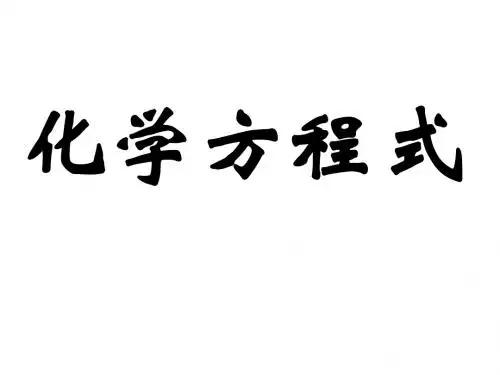
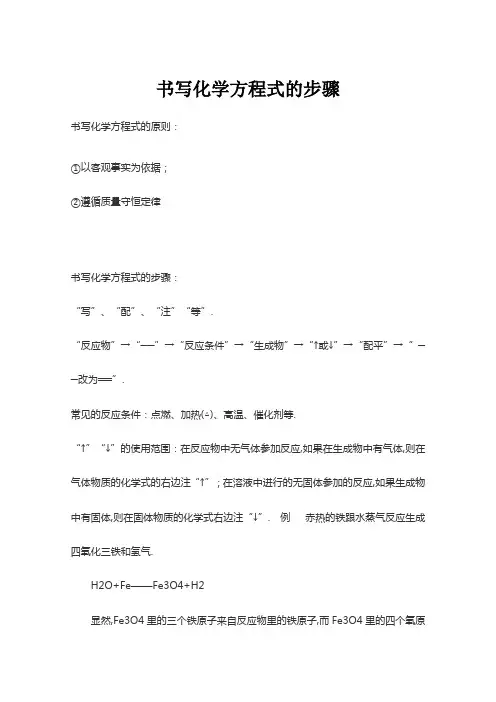
书写化学方程式的步骤
书写化学方程式的原则:
①以客观事实为依据;
②遵循质量守恒定律
书写化学方程式的步骤:
“写”、“配”、“注”“等”.
“反应物”→“──”→“反应条件”→“生成物”→“↑或↓”→“配平”→“──改为══”.
常见的反应条件:点燃、加热(△)、高温、催化剂等.
“↑”“↓”的使用范围:在反应物中无气体参加反应,如果在生成物中有气体,则在气体物质的化学式的右边注“↑”;在溶液中进行的无固体参加的反应,如果生成物中有固体,则在固体物质的化学式右边注“↓”. 例赤热的铁跟水蒸气反应生成四氧化三铁和氢气.
H2O+Fe——Fe3O4+H2
显然,Fe3O4里的三个铁原子来自反应物里的铁原子,而Fe3O4里的四个氧原
子又来自反应物水蒸气分子里的氧原子.因此,在反应物水蒸气化学式前必须写一化学计量数4,而铁原子前必须写一化学计量数3.
4H2O+3Fe——Fe3O4+H2
不难看出,在生成物氢的化学式前写一化学计量数4,才能使化学方程式配平.然后注明反应条件.
4H2O+3Fe==高温== Fe3O4+4H2
也就是,
观察法配平化学方程式
有氢以氢作标准,无氢以氧为准绳;
调整只能改系数,原子各等就配平.
氢氧全无找一价,变单成双求配平;
配平系数现分数,全式乘2必平整.。
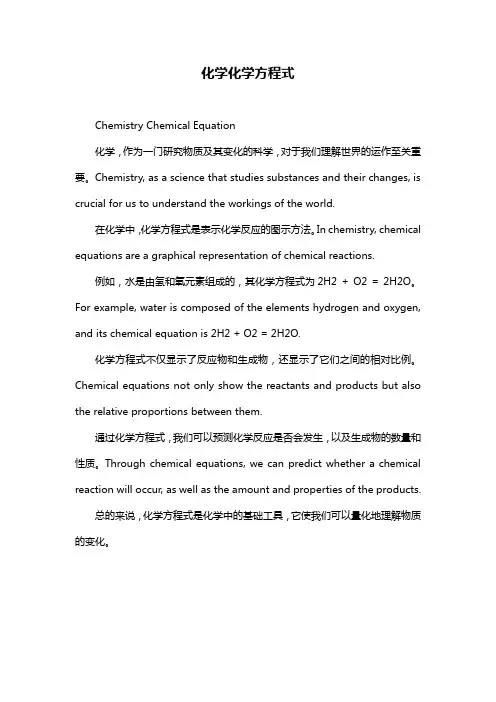
化学化学方程式Chemistry Chemical Equation化学,作为一门研究物质及其变化的科学,对于我们理解世界的运作至关重要。
Chemistry, as a science that studies substances and their changes, is crucial for us to understand the workings of the world.在化学中,化学方程式是表示化学反应的图示方法。
In chemistry, chemical equations are a graphical representation of chemical reactions.例如,水是由氢和氧元素组成的,其化学方程式为2H2 + O2 = 2H2O。
For example, water is composed of the elements hydrogen and oxygen, and its chemical equation is 2H2 + O2 = 2H2O.化学方程式不仅显示了反应物和生成物,还显示了它们之间的相对比例。
Chemical equations not only show the reactants and products but also the relative proportions between them.通过化学方程式,我们可以预测化学反应是否会发生,以及生成物的数量和性质。
Through chemical equations, we can predict whether a chemical reaction will occur, as well as the amount and properties of the products.总的来说,化学方程式是化学中的基础工具,它使我们可以量化地理解物质的变化。

常用英文化学分子式、方程式及数学式的读法Na2SO4 Sodium sulphate; N-a-two-S-O-fourMg(OH)2 magnesium hydroxide; M-g-pause-O-H-pause-twice; M-g-in brackets twice Ca2(PO4)3· 2H2O calcium phosphate two hydrate; C-a-two-pause-P-O four-pause- three times-dot-two-H two-O[Zn(NH3)4]2+ tetra-ammonium zinc complex cationgive; yield; produce, form,becomeevolved as a gas; give off a gasis precipitated; gives X precipitate= reacts reversibly--------------------------------------------------------------------------------Cu, D in the precence of a copper as a catalyst on heatingCO32- + Ca2+ = CaCO3 a carbonate anion with a valancy of two plus a calcium cation with a valancy of two produce a calcium carbonate precipitateR’ R primeR” R double prime, R second primeR1 R sub one100° C one hundred degrees Centigrade+ plus; positive- minus; negative´ multiplied by; times¸ divided by± plus or minus= is equal to; equalsº is identically equal to» is approximately equal to( ) round brackets; parentheses[ ] square brackets{ } bracesa>>b a is much greater than ba³ b a is greater than or equal to baµ b a varies directly as blognX logX to the base nthe cubic root of xthe nth root of xx2 x square, x squared, the square of xXn X to n factors; the nth power of x; x to the power nx -8 x to the minus eighth powerï xï the absolute value of xthe mean value of Xthe sum of the terms indicated; summation ofD x or d x the increment of xdx differential xdy/dx the first derivative of y with respect to xò integral¥ infinity1/2 a half; one half2/3 two thirds5/123 five over a hundred and twenty-threeeight and three over fourths; eight and three quarters0.01 O point O one; zero point zero one; nought point nought one6 % 6 percent3‰ 3 per mille2 :3 the ratio of two to threer=xd r equals x multiplied by d5´ 2=10 five times two equals tenx3/8=y2 x raised to the third power divided by eight equals y squared(a+b-c´ d)/e=f a plus b minus c multiplied by d, all divided by e equals f y = (Wt-W)/x y equals W sub t minus W over x。
化学方程式的书写方法一、简介化学方程式是化学反应的符号表示方法,它能够清晰地揭示反应物、生成物和反应条件,是科学家和学生研究和理解化学反应的重要工具。
本文将介绍化学方程式的书写方法,包括平衡方程式的书写和化学反应条件的标注。
二、平衡方程式的书写平衡方程式是指在化学反应中,反应物与生成物的种类和数目在化学方程式中保持一致。
以下是平衡方程式的书写方法:1. 写出反应物和生成物:化学方程式的左边写上反应物,用"+"号隔开;右边写上生成物,同样用"+"号隔开。
2. 确定物质的化学式:根据反应物和生成物的种类,确定它们的化学式。
化学式表示物质中原子的种类和数目,包括元素符号和下标。
3. 平衡原子的数目:根据化学式中原子的种类和数目,平衡方程式中各元素的数目。
可以通过在化学式前面添加系数来平衡化学方程式。
4. 检查方程式是否平衡:在写好方程式后,检查方程式中各元素的数目是否平衡。
如果不平衡,可以适当调整系数来平衡方程式。
示例:燃烧甲烷生成二氧化碳和水的方程式为:CH4 + O2 -> CO2 + H2O三、化学反应条件的标注化学方程式中的反应条件对于理解和研究反应过程非常重要。
以下是标注化学反应条件的方法:1. 使用符号表示反应温度:在方程式的反应物和生成物之间添加符号表示反应温度,一般使用大写字母代表。
2. 使用符号表示反应压力:在方程式的反应物和生成物之间添加符号表示反应压力,一般使用上标。
3. 使用符号表示催化剂:在方程式的箭头上方添加符号表示催化剂的存在,一般使用催化剂的化学式写在箭头上方。
示例:氢气和氧气在催化剂的存在下生成水的方程式为:2H2 + O2 -> 2H2O(催化剂)四、其他注意事项在书写化学方程式时,还需遵守以下注意事项:1. 方程式两边物质的种类和数目必须保持一致,反应物与生成物的数目要相等。
如果不平衡,应通过调整系数使之平衡。
2. 方程式中的化学式和化学符号应准确无误,不得出现拼写错误或符号错误。
国外的化学方程式嘿,朋友们!今天咱们来聊聊国外那些化学方程式,就像是打开一扇通往神奇化学世界的大门。
先来说说水的电解这个经典的反应吧,2H₂O = 2H₂↑+ O₂↑。
这就像是水分子在进行一场超级变身秀。
水原本安安静静地待在那里,就像一个低调的小透明。
可是一旦通上电,好家伙,就像被施了魔法一样,水分子瞬间分裂成氢气和氧气。
氢气就像一个个调皮的小气球,急着往上飘;氧气呢,就像个默默支持的小伙伴,虽然不如氢气那么活泼地往上跑,但也是这个反应中不可或缺的一部分,要是没有氧气,这就像一场只有主角没有配角的戏,可就不完整啦。
再看铁和硫酸铜的反应,Fe + CuSO₄ = FeSO₄+ Cu。
这简直就是一场金属之间的“换位游戏”。
铁就像一个勇敢的小战士,一头扎进硫酸铜溶液这个大战场。
硫酸铜溶液呢,蓝色的,就像一片神秘的蓝色海洋。
铁进去之后,就把铜给置换出来了,就像小战士把原本坐在王位(溶液里的铜离子)上的铜给赶了下去,自己取而代之,而被置换出来的铜就像一个被赶下台的小国王,只能无奈地以固体的形式出现啦。
然后是碳酸钙高温分解的反应,CaCO₃ = CaO + CO₂↑。
碳酸钙就像一个坚固的小城堡,平时稳稳当当的。
可是一旦遇到高温这个大怪兽,就招架不住啦。
它分解成氧化钙和二氧化碳。
二氧化碳就像一个小幽灵,一下子就跑掉了,留下氧化钙这个“孤单的守卫者”。
这就好比城堡被攻破,里面的居民(二氧化碳)都四处逃窜,只留下空荡荡的建筑框架(氧化钙)。
还有氢气在氧气中燃烧的反应,2H₂+ O₂ = 2H₂O。
这就像一场盛大的烟花表演。
氢气和氧气就像两个充满活力的舞者,当它们相遇并点燃的时候,就会产生美丽的火焰,然后它们紧紧拥抱在一起,融合成了温柔的水。
这就像是两个热情的人在爱情的火花下结合成了一个新的整体,多么浪漫又神奇的化学变化呀。
再瞧瞧镁在空气中燃烧的反应,2Mg + O₂ = 2MgO。
镁条就像一个充满能量的小火箭,一点燃,那光芒简直亮瞎眼。
latex化学方程式
\textbf{前言}
化学方程式是用来描述化学反应过程的简单符号语言。
它是把反应化学物质用符号表示出来,并用箭头表示反应遵循的规律,以及显示物质在反应中的变化情况。
大部分化学反应可以用化学方程式来记录和表达,这有助于实验室工作人员以及教学活动。
化学方程式由两个部分组成:化学物质符号和反应物箭头。
1.\ 化学物质符号:用一种语言(比如分子式)表示反应物的化学事物,这些化学物质符号是反应物在反应中产生的化学变化的基础。
2.\ 反应物箭头:反应物的箭头表示反应的方向,箭头的指向表示物质影响和反应物之间发生的交互作用,从而表示物质在化学反应中的变化情况。
水气燃烧反应可以用以下化学方程式来表示:
2H$_2$ + O$_2$ → 2H$_2$O
在上面的方程式中,左边的 2H$_2$ 和 O$_2$ 是反应的反应物,即水气(H$_2$)和氧气(O$_2$);向右的 2H$_2$O 是反应的产物,即水和氧气经过燃烧后所产生的产物——水(H$_2$O)。
同时,这个方程式上面的箭头也表示了这个反应的方向——从反应物到产物。
国外AP无机化学方程式常考总结
写出下列反应的方程式,能写离子方程式的尽量写离子方程式。
1. A solution of ammonia is added to a dilute solution of acetic acid(醋酸).
2.Solutions of sodium hydroxide and acetic acid are mixed.
3.Hydrogen sulfide gas is bubbled through excess potassium hydroxide solution.
4.Write the successive(连续的)ionization equations for H2S.
5.Solid barium oxide is added to distilled water
6. Solid calcium oxide is exposed to a stream of carbon dioxide gas.
7. Solid dinitrogen pentoxide is added to water.
8. Carbon disulfide vapor is burned in excess oxygen to give two kinds of oxides.
9.Lithium metal is burned in air.
10.Excess concentrated sodium hydroxide solution is added to solid aluminum hydroxide.
11. Solid ammonium carbonate is heated.
12. A solution of hydrogen peroxide(过氧化氢) is catalytically decomposed.
13. A solution of potassium chloride is electrolyzed.
14.A solution of ammonium sulfate is added to a saturated solution of barium hydroxide.
15.A solution of copper(II) chloride is added to a solution of sodium sulfide.
16. Solutions of manganese(II) sulfate and ammonium sulfide are mixed.
17. Chlorine gas is bubbled into a cold, dilute solution of
potassium hydroxide.
18. Chlorine gas is bubbled into a cold, dilute solution of potassium hydroxide.
19. A strip of copper is immersed in a concentrated nitric acid solution.
20. Hydrogen gas is passed over hot iron(II) oxide powder.
21. Acidified(酸化)potassium permanganate is added to a solution of sodium nitrite. (hints:under acidic solution ,MnO4-can be reduced into Mn2+;NO3-can be oxidized into NO3-).
22. A solution of sodium bromide is added to an acidified solution of potassium bromate.
23.Aluminum metal is added to a solution of copper(II) chloride.
24. Excess chlorine gas is passed over hot iron filings.
25. Magnesium metal is added to nitrogen gas.
26. Solid lithium hydride is added to distilled water.(LiH中H的氧化数为-1,很容易升高)
27. Solid lithium oxide is added to excess water.
28.Solid potassium chlorate is heated in the presence of manganese dioxide as a catalyst.
29. Dilute hydrochloric acid is added to a solution of potassium sulfite.
30. A solution of sulfuric acid is added to a solution of barium hydroxide until the same number of moles of each compound has been added.
31.Sulfur dioxide gas is passed over solid calcium oxide.
32. A solution of potassium iodide is added to an acidified solution of potassium dichromate(Cr2O72-). (hints:under acidic solution , Cr2O72-can be reduced into Cr3+;I-can be oxidized into I2).。